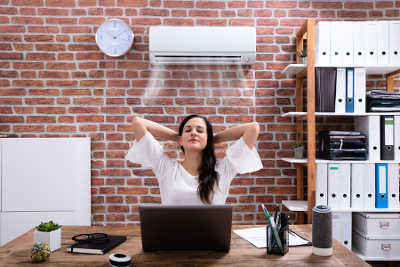Feel the Chill
 Air conditioners keep you cooler than anything else on the market right now. They’ve been around for over 100 years for one simple reason – they work! Aircon units, while a bit more refined these days, are essentially the same today as when they were first invented in 1902. So, how do these seemingly timeless machines work? Keep reading for an in-depth guide to the technology behind air conditioning!
Air conditioners keep you cooler than anything else on the market right now. They’ve been around for over 100 years for one simple reason – they work! Aircon units, while a bit more refined these days, are essentially the same today as when they were first invented in 1902. So, how do these seemingly timeless machines work? Keep reading for an in-depth guide to the technology behind air conditioning!
Simple Rules
Air conditioning relies on two simple laws of physics. The first is that, whenever a liquid evaporates, it has to use some heat energy to do so. The second is that, if you compress a gas, it becomes much easier to turn back into a liquid (a process known as condensation). Air conditioners use both of these laws to turn coolant liquid into a gas before condensing it back into a liquid in a constant loop, meaning they suck a massive amount of heat out of the air. All air conditioners work the same way, from massive industrial units to the small model that’s fitted in your car.
Cooling the Air
 When you first switch your aircon on, a fan inside the unit starts to spin. This draws warm air into the system and blows it over an ice-cold pipe that’s full of refrigerant. Refrigerant is what’s called an unstable liquid, which simply means it’s very easy to make it change state (from a liquid to a gas and vice versa). The warm air causes the refrigerant to heat up and rapidly evaporate, which instantly sucks a lot of the heat energy out of the air. This freshly-chilled air is blown out into your room, but the process doesn’t end there!
When you first switch your aircon on, a fan inside the unit starts to spin. This draws warm air into the system and blows it over an ice-cold pipe that’s full of refrigerant. Refrigerant is what’s called an unstable liquid, which simply means it’s very easy to make it change state (from a liquid to a gas and vice versa). The warm air causes the refrigerant to heat up and rapidly evaporate, which instantly sucks a lot of the heat energy out of the air. This freshly-chilled air is blown out into your room, but the process doesn’t end there!
Feeling the Heat
The refrigerant inside the aircon isn’t much use in its current state as a hot gas. The air conditioner must cool it down before it can use it to chill the air again. To do this, it’s first pumped through a compressor and then a condenser, both of which work together to turn it back into a cooler liquid again. The liquid coolant is pumped back around the system and this process repeats in a neverending loop.
Being Exhausted
 You might know that you can’t really make heat simply disappear – you can only transfer the energy somewhere else. When the hot gas inside the aircon is compressed, the heat it contains has to go somewhere. This is why all air conditioners are fitted with an exhaust to vent out this excess heat! If you’re looking at a portable aircon unit, it’s important to remember this as these models are fitted with a long duct that trails out from the back of the unit. This duct will need to be trailed out of an open window or door, so it’s worth considering when thinking about where to put your air conditioner.
You might know that you can’t really make heat simply disappear – you can only transfer the energy somewhere else. When the hot gas inside the aircon is compressed, the heat it contains has to go somewhere. This is why all air conditioners are fitted with an exhaust to vent out this excess heat! If you’re looking at a portable aircon unit, it’s important to remember this as these models are fitted with a long duct that trails out from the back of the unit. This duct will need to be trailed out of an open window or door, so it’s worth considering when thinking about where to put your air conditioner.
Dehumidifying Effect
Air conditioners were actually invented to dehumidify the air in printing presses – at first, the whole air-cooling thing was actually just a by-product of that! Cool air holds less moisture than warm air, which means it’ll naturally lose water as it cools down. This water has to go somewhere, so most air conditioners use a water tank to collect it which you’ll have to empty every now and then. Some models use water-recycling technology or plumbing to get rid of their waste water, too.
When to Use an Air Conditioner
This simple process is incredibly effective, and it’s the reason why air conditioners give out the refreshing, ice-cold blast of air that they’re known for. If you need instant air cooling in a very large or stiflingly hot room, accept no imitation – an aircon is the right choice for you!


